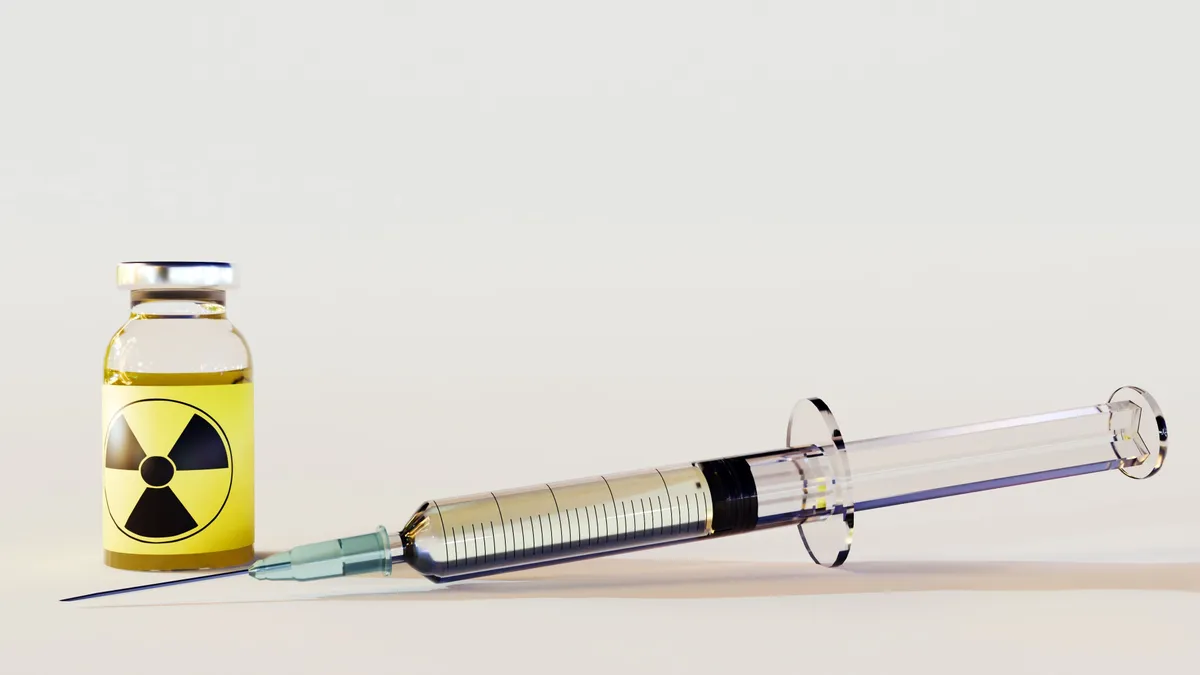As far as cancer treatments go, radiopharmaceuticals are conceptually one of the simplest — radioactive substances are very good at killing cancer cells, after all. And as targeting mechanisms improve, Big Pharma has taken a renewed interest in the area’s potential, driving more innovation at smaller companies developing radiopharmaceuticals of their own.

While the pharma industry may be seeing a radio-renaissance, the idea has been around since the years following World War II, said Jack Hoppin, CEO of the radiopharmaceutical company Ratio Therapeutics.
“It’s not a novel concept to put a radioisotope into patients,” Hoppin said, referring to the radioisotope iodine-131 that was first used in 1951 to treat thyroid conditions.
Decades later in the early 2000s, GlaxoSmithKline’s Bexxar and Spectrum Pharmaceuticals’ Zevalin were both approved to treat lymphoma, but sales suffered due to logistical issues.
Beyond prolific diagnostic use for PET imaging and another radioisotope Xofigo from Bayer that was approved in 2013 for prostate cancer, two modern treatments brought therapeutic radiopharmaceuticals back into the spotlight, Hoppin said: Lutathera for neuroendocrine tumors and Pluvicto for prostate cancer, both acquired by Novartis in 2017 and 2018, respectively. Pluvicto in particular could become the first blockbuster drug in the space this year, according to reports.
“There have been a couple other successes in the space, but those are the two driving forces that caught everyone’s eye,” Hoppin said. “When a buyer like Novartis steps in and starts building infrastructure, and oncologists are willing to prescribe and treat directly with these drugs, it builds momentum.”
“People in pharmaceutical sciences underestimate nuclear medicine, and people in nuclear medicine underestimate pharmaceutical sciences."

Jack Hoppin
CEO, Ratio Therapeutics
Backed by another pharma giant, Bristol Myers Squibb, Ratio is still in early days with radiopharmaceuticals, also called radioligand therapies, as it seeks regulatory go-ahead for a phase 1 trial to treat soft tissue sarcoma, as well as several other therapeutic and diagnostic programs in preclinical stages.
“I think you’ll see these drugs evolve in the way that antibody-drug conjugates have — it took time to adopt and come to fruition, but we’re now in an era where companies are looking for fit-for-purpose molecules for radioligand therapy and the characteristics required to be successful,” Hoppin said.
Multi-disciplinary approach
One of the most important factors in therapeutic radiopharmaceuticals is finding the right balance between dosing and targeting to kill cancer cells without triggering harmful side effects.
To get that balance right requires more than just biology and chemistry, said Hoppin, who has a Ph.D. in mathematics. For example, understanding the way radioactive material — actinium-225 in Ratio’s case — populates a tumor and expanding the window of time that material is present is as much a math problem as it is biological.
“People in pharmaceutical sciences underestimate nuclear medicine, and people in nuclear medicine underestimate pharmaceutical sciences — we try to acknowledge that you’re only as good as the weakest disciplinarian within your group,” Hoppin said, adding that Ratio has medical, chemical, radiological, biological, pharmacological, mathematical, physical and dosimetric specialties all at once. “We’re a small, nerdy company just discovering and developing molecules with a goal of getting compounds for different targets into patients.”
Ratio uses actinium-225 with a combination of platforms for targeting and linking to ensure a calculated dose. From a mathematical modeling perspective, Hoppin believes small molecules like radiopharmaceuticals are ideal for treating solid tumors.
And while advances in protein engineering or virology can lead to major biological breakthroughs that come in waves, he credits a steady accumulation of better biomarkers for growth in the therapeutic radiopharmaceutical space.
“There wasn’t a clear-cut smoking gun that changed the market, but more an evolution of medicinal chemistry and biomarker technology to image these agents faster and more quantitatively,” Hoppin said.
Building the market
Ratio is among a dozen or so small- to mid-sized startups exploring radiopharmaceuticals, and acquisitions by Big Pharma players have given rise to a thriving market for clinical-stage developers.
At the end of last year, Bristol Myers Squibb announced a $4.1 billion acquisition of RayzeBio, and that same week, Eli Lilly completed a $1.4 billion purchase of Point Biopharma. Both companies have radiopharmaceutical candidates in clinical trials and marked a sizable investment in the space compared with the decadeslong lull.
This year, AstraZeneca bought Fusion Pharmaceuticals for $2.4 billion, continuing the M&A trend. There were 86 deals in the radiopharmaceuticals space in the last five years, according to a Nature report, and the number of deals nearly tripled from 2021 to 2022, mostly for preclinical companies.
There are still challenges in the field, as Hoppin can attest, from manufacturing of radioactive materials to supply chain and storage. But the future looks bright.
“Some of these things can’t be instantly solved, but looking out a decade, there are going to be multiple approvals and really exciting times,” Hoppin said.



















